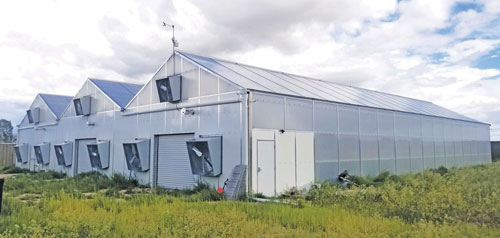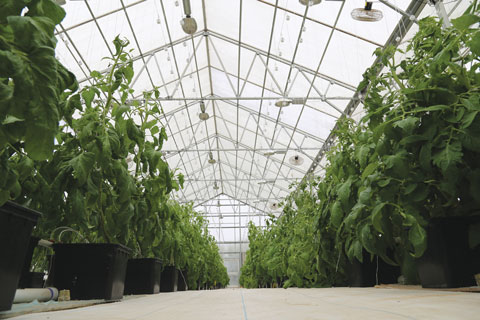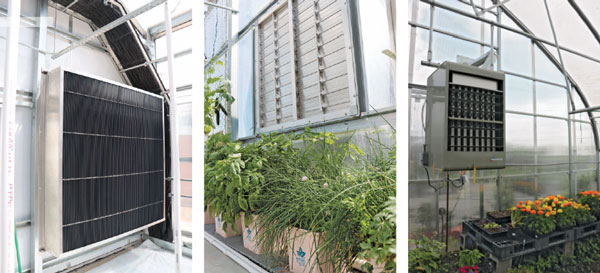6/1/2022
Is It Time for an Upgrade?
Patrick Mahoney
Keeping a structure up-to-date in today’s evolving horticultural landscape presents a constant challenge for growers. There are seemingly always new ways to improve, turning the industry standard of a modernized greenhouse into a moving target that operations have to try their best to achieve.
Still, there are ways for you to do what you can to stay current. Improving on an existing production space offers an effective solution for many operations and it can often be the superior choice, depending on your budget and available resources. New builds might not be for every operation, and with growers continuously looking for ways to keep costs down, retrofitting an existing structure can be just as effective as building a new greenhouse entirely.
 Pictured: Due to the importance of light transmission, the roof is the most important thing you would want to retrofit with new cladding right out of the gate.
Pictured: Due to the importance of light transmission, the roof is the most important thing you would want to retrofit with new cladding right out of the gate.
You can implement new structural materials, equipment and design elements to upgrade your current grow space, getting the most out of your budget and making your greenhouse more modern to keep pace with competitors. With the right design choices, your operation can have a freshly updated greenhouse that gives you the best chance for success going forward.
Starting with the structure
On the structure itself, new cladding is going to be the most important upgrade for you to consider. The right cladding will provide a greenhouse with valuable insulation and durability, as well as the light transmission crops need to thrive.
While replacing cladding on all sections of the greenhouse is generally a good idea, operations don’t always have to reclad their entire structure. Instead, they can focus their resources on what will have the most meaningful impact on crop growth.
If you’re looking to conserve your budget while getting the most potential out of your structure, upgrading your greenhouse roof will offer the biggest improvement to production.
“The roof is the most important thing you would want to retrofit with new cladding right out of the gate, largely because of light transmission,” said Matthew Hively, a Greenhouse Designer for GrowSpan Greenhouse Structures. “Light is the driving factor for your plant production, so if you don’t have good light transmission, your plants and production are going to be affected.”
According to Matthew, it’s also vital for you to keep historical records of production over time. This way, you can draw a correlation between their cladding and how the deterioration of that cladding affects output. When it comes time to retrofit, you’ll be able to make a more informed decision about which cladding you should get, as well as have a better understanding of how long that cladding lasts and what your return on investment will be until you need to reclad again.
Upgrading greenhouse equipment
Bringing in new, updated equipment is going to go a long way towards reaching your production goals. Typically, systems like HVAC and irrigation should already be set up effectively, and therefore unnecessary to change. As a result, you can turn to other elements like new lighting and automation packages to improve your structure.
“If I were to suggest two things to consider right out of the gate, it’s controls and lighting,” said Matthew.
While the latest lighting systems can offer improvements to crop growth anywhere, their impact in a greenhouse will vary, depending on where an operation is located.
“In a northern state, like Oregon or Washington, those growers can benefit a lot from new lights,” continued Matthew. “You can essentially make up the lost daylight interval through lighting and achieve the same kind of lighting pattern that you would get in a location like Southern California, where you have sunlight all day every day for most of the year.”
 Pictured: It’s very difficult to increase the physical growing area in many greenhouse operations, but it’s a lot easier to start to zoom in on the already existing space and rearrange to get improved results.
Pictured: It’s very difficult to increase the physical growing area in many greenhouse operations, but it’s a lot easier to start to zoom in on the already existing space and rearrange to get improved results.
Using different light frequencies, a new lighting package can then give you the ability to influence the way your crops grow over their lifetime. So not only can operations add more light to their greenhouse footprint and increase production, but they also can manipulate their structure’s lighting to produce very specific results in their crops.
Automation is also an important, and often necessary, upgrade for growers to invest in. Matthew emphasized that if growers implement new lights, they can “use minimal automation with that new lighting package and achieve some really great results.”
Lighting and automation offer an excellent pair of upgrades, but you should also exercise caution when incorporating automated controls into your structure.
“Don’t automate your greenhouse unless you have a really good understanding of your growing system and how you grow,” said Matthew. “You need to understand the things that are easy to automate and difficult to automate, and also get a general understanding of your workers’ workflows.”
If you do want to upgrade your greenhouse with automation, beginning with a smaller portion of the structure can be a manageable strategy that allows you to develop at a more comfortable pace.
“Start small with something like propagation and automate your propagation area to figure out if you like that specific control system,” explained Matthew.
Maximizing production space
During a retrofit, a common goal for growers is figuring out how they can better take advantage of their structure’s usable space to increase output.
“It’s very difficult to increase the physical growing area in many greenhouse operations, but it’s a lot easier to start to zoom in on the already existing space and rearrange it in a slightly better way to get improved results,” said Matthew.
 Pictured far left: Automated HVAC systems can lower energy costs, boosting profits.
Pictured far left: Automated HVAC systems can lower energy costs, boosting profits.
Center: Vents or shutters are a great way to improve greenhouse ventilation.
Near left: HVAC Equipment should be regularly checked so it doesn’t break down before the season for which it is needed the most.
An efficient way to accomplish this is for you to again look at your propagation area. Propagation is typically much smaller than any other portion of the greenhouse, so many times it can be one of the easiest and cheapest ways to upgrade. Matthew said that growers can, “speed up the growing process in propagation a lot of different ways and make changes to that area much more easily than they can with big, established growing systems.”
By making your propagation area more efficient, you can get more potential out of your production space in a relatively inexpensive way. You can also take propagation a step further by creating a germination room within your greenhouse.
“Growers can get an even faster jumpstart on propagation if they provide themselves with a germination room,” said Matthew. “You can take all of your trays and stack them on carts vertically, then roll them into the germination room and germinate them for three days to get a huge jump on that growing cycle for plants.”
Adding a germination room can have a considerable effect on an operation’s quantity of plants per growing cycle. By upgrading your structure with a small section to better develop seedlings, you may potentially set yourself up for increased profits through every harvest.
For growers trying to keep their operation up-to-date, building a new structure doesn’t have to be the only viable option. By making the right design choices to get the most out of your budget and current structure, you can drastically increase productivity and help your operation flourish. GT
Patrick Mahoney works for GrowSpan Greenhouse Structures. For more information visit www.GrowSpan.com.